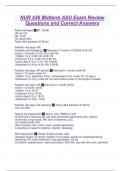NUR 436 Midterm ASU Exam Review
Questions and Correct Answers
Adults vital signs ✅BP: 120/80
HR: 60-100
RR: 12-20
O2: above 95%
Temp: 98.6 (between 97-99 ok)
Pediatric vital signs: HR
A(awake) and S(sleeping) ✅-Neonate 0-1 month: A 100-205; S 90-160
-Infant 1-12 month: A 100-180; S 90-160
-Toddler 1-3 yr: A 98-140; S 80-120
-Preschool: 3-6 yr: A 80-120; S 65-100
-School Age 6-12 yr: A 75-118; S 58-90
-Adolescent 12-18 yr: A 60-100; S 50-90
Pediatric vital signs: BP systolic ✅-Neonate 0-1 month: under 60
-Infant 1-12 month: under 70
-Toddler 1-3 yr, preschool: 3-6 yr:, school age 6-12 yr: under 70 + 2x age yr
-Adolescent 12-18 yr: under 90, but will increase closer to 120 as age increases
Pediatric vital signs: RR ✅-Neonate 0-1 month: 30-60
-Infant 1-12 month: 30-53
-Toddler 1-3 yr: 22-37
-Preschool: 3-6 yr: 20-28
-School Age 6-12 yr: 18-25
-Adolescent 12-18 yr: 12-20
Pediatric vital signs: O2 and temp ✅-Temp: 98.6 (between 97-99 ok)
-O2: over 95%
Head to toe assessment ✅-Neuro: LOC, PERRLA, AxO
-CV/perfusion: heart sounds, cap refill, extremities (warm/cold, color, edema)
-Pulmonary: lung sounds, RR, work of breathing, LOC
-GI: bowel sounds, I&O
-Skin: bruising, color, intact, turgor, overall appearance
-Lines/drains: inspect for patency, infection, dressings
ABC assessment ✅-Airway: breath sounds, voice
(Swallow screen: sit upright, swallow 3 oz of water, assess for coughing/choking)
-Breathing: RR, chest movement, lung auscultation, O2 sat
-Circulation: palpate pulse, heart auscultation, EKG, BP, cap refill, skin color, dry/moist
, Ventricular fibrillation (V-fib) ✅-No coordinated activity, ventricle quivering, messy on
EKG
-Patient will not have a pulse
-CODE BLUE: CPR, defibrillate, ACLS
Ventricular tachycardia (V-tach) ✅-LETHAL - fast dysrhythmias
-Wide and fast QRS's
-May or may not have pulse, but will eventually lose pulse
-Pulse present: oxygen, cardioversion, amiodarone
-No pulse: CODE BLUE - CRP, defibrillate
SVT/PSVT ✅-Normal QRS, may be narrow
-Unable to separate P wave / T wave
-Interventions: oxygen, vagal maneuvers, adenosine, synchronized cardioversion
Vagal manuevers ✅-Ice to face
-Valsalva maneuver
-Carotid sinus massage
-Bear down
Medications for dysrhythmia ✅-Epi: 1mg q3-5 min (adult), 0.01mg/kg q 3-5 min 1mg
max (peds)
-Amiodarone: 300mg bolus (adults), 5mg/kg bolus 3x (peds)
-SPEED up heart: atropine, pacing, epi
-SLOW down heart: vagal maneuvers, amiodarone, adenosine, beta-blockers, calcium
channel blockers, synchronized cardioversion
Nursing interventions for care of tracheostomy and suctioning ✅-Suction PRN, no
order needed
-One right size and one size smaller tubes at the bedside
-Indications: adventitious breath sounds, nasal flaring, retractions, mucus, low O2 sats,
coughing, cyanosis, abnormal RR
-Can also elevate head of head and give O2
-Deep trach suctioning: one hand sterile, one hand clean, suction 5 seconds in and 5
seconds out, use sterile water or sterile NS, 30-second recovery time between suctions
-ALWAYS auscultate after, assess O2, assess patient color
-Need to have ambu bag + mask, humidified O2, suction, obturator, 2 trach tubes in
room, peds code sheet
Nursing interventions for care of ventilator ✅-High pressure alarm: pulmonary edema,
pneumothorax, bronchospasm, biting, secretions, cough, kink, fighting the vent,
condensation/water in tubing
-Low-pressure alarm: low pressure, cuff leak, tube displacement/extubation,




